Abstract
To compare their effects on nitrogen balance, diets containing either lactalbumin whole protein, its peptide-rich enzymic hydrolysate or an equivalent mixture of free amino acids as the sole source of dietary nitrogen were fed to two healthy subjects, each studied for 38 days on two separate occasions. The nitrogen intake (47 mg/kg body wt/day) induced a state of negative nitrogen balance, stimulating nitrogen conservation. Net daily nitrogen balance (mean +/- SD) in subject 1 was -0.23 +/- 0.72 g (amino acids) vs + 0.05 +/- 0.52 g (protein) and -0.21 +/- 0.58 g (amino acids) vs -0.05 +/- 0.57 g (hydrolysate), and in subject 2, -0.19 +/- 0.60 g (amino acids) vs -0.16 +/- 0.51 g (protein) and -0.42 +/- 0.35 g (amino acids) vs -0.62 +/- 0.34 g (hydrolysate). Analysis of these results by the cumulative sum technique showed no significant differences in the effect of the three nitrogen sources on nitrogen balance. This study indicates that there is no nutritional evidence to support the current practice of prescribing expensive enteral diets containing peptides or amino acids rather than the much cheaper whole protein to patients with normal gastrointestinal function.
Full text
PDF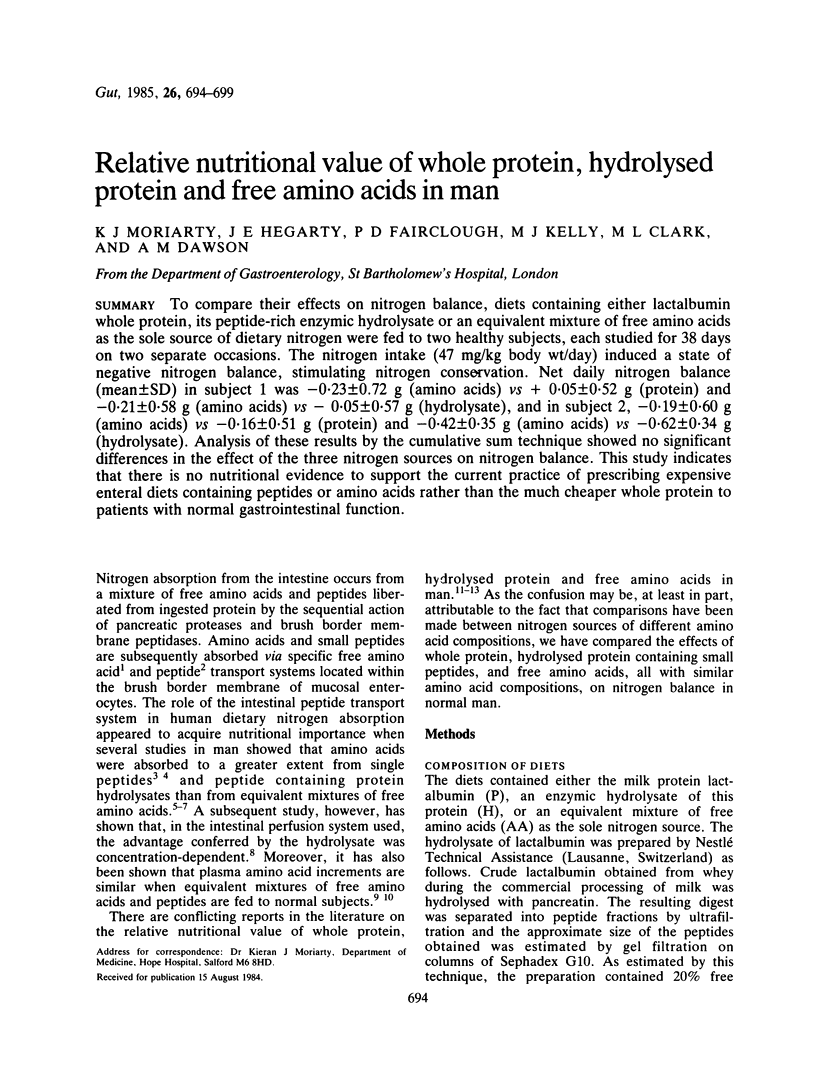
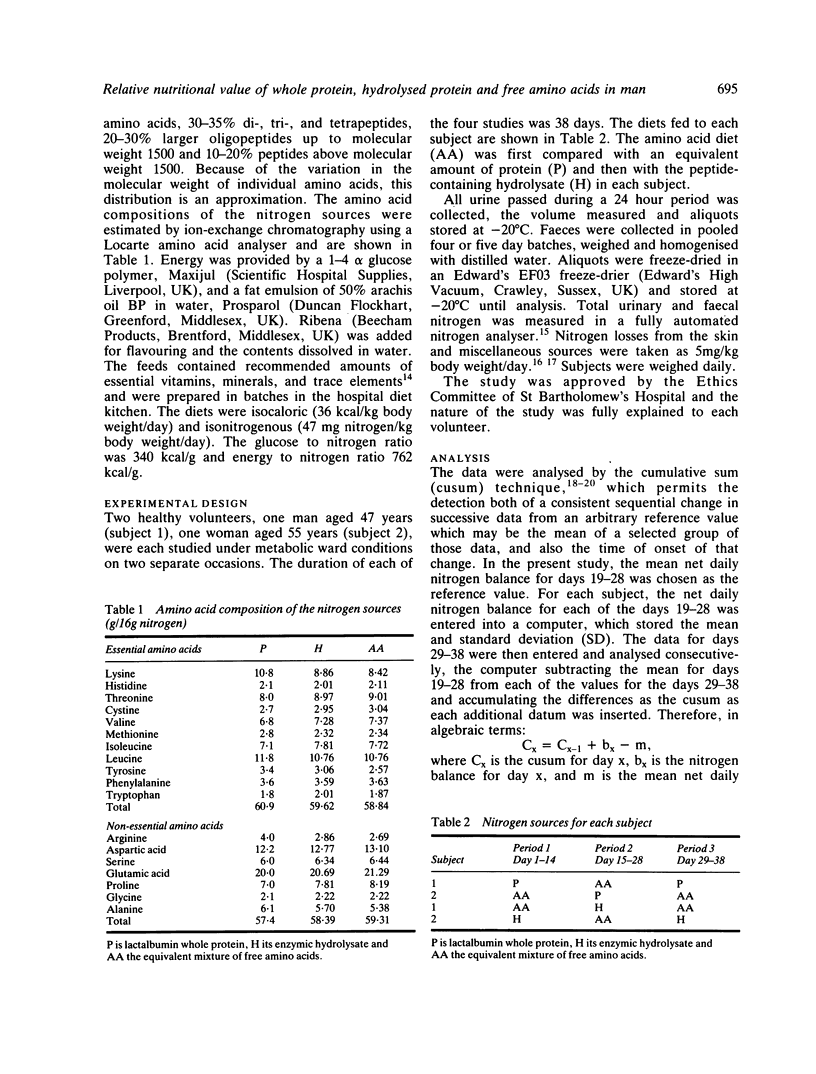
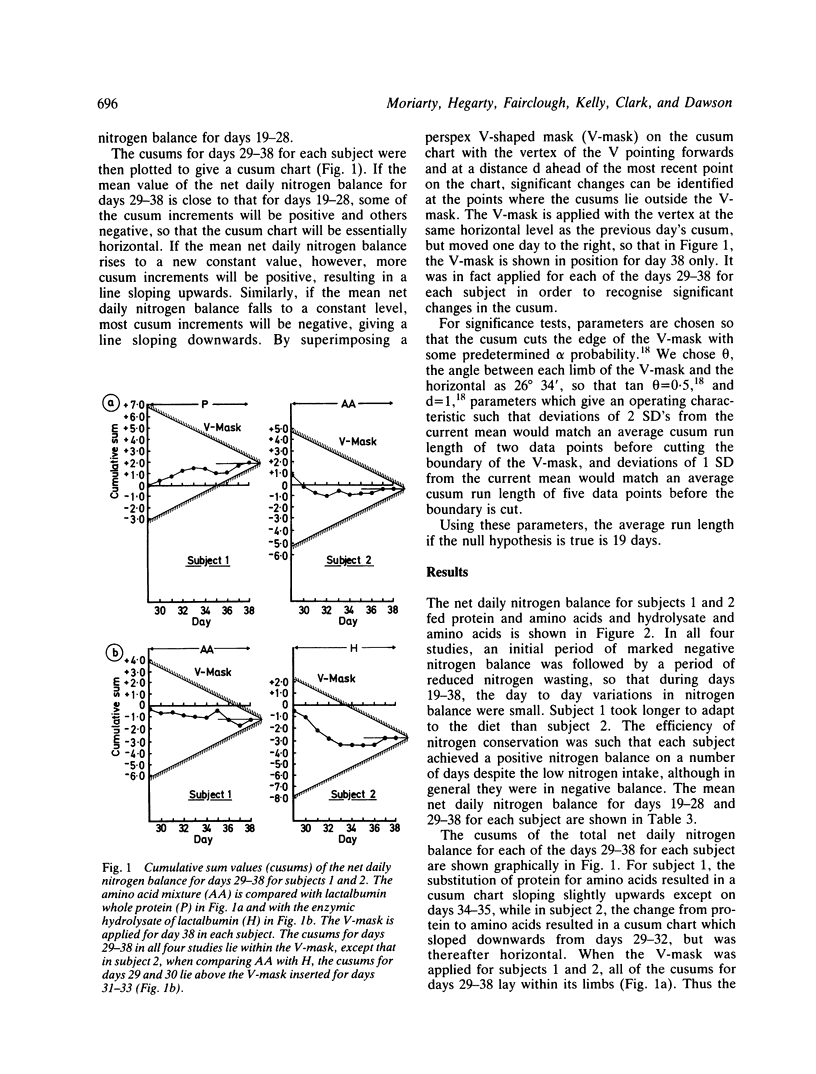
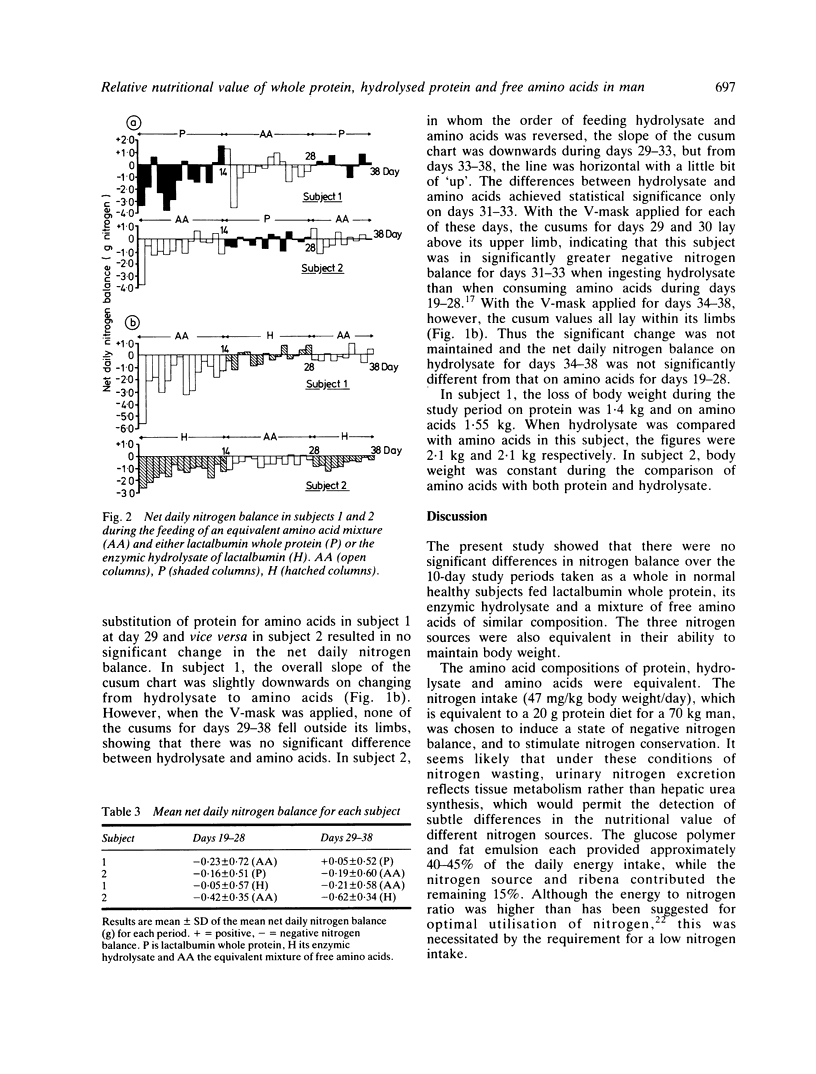
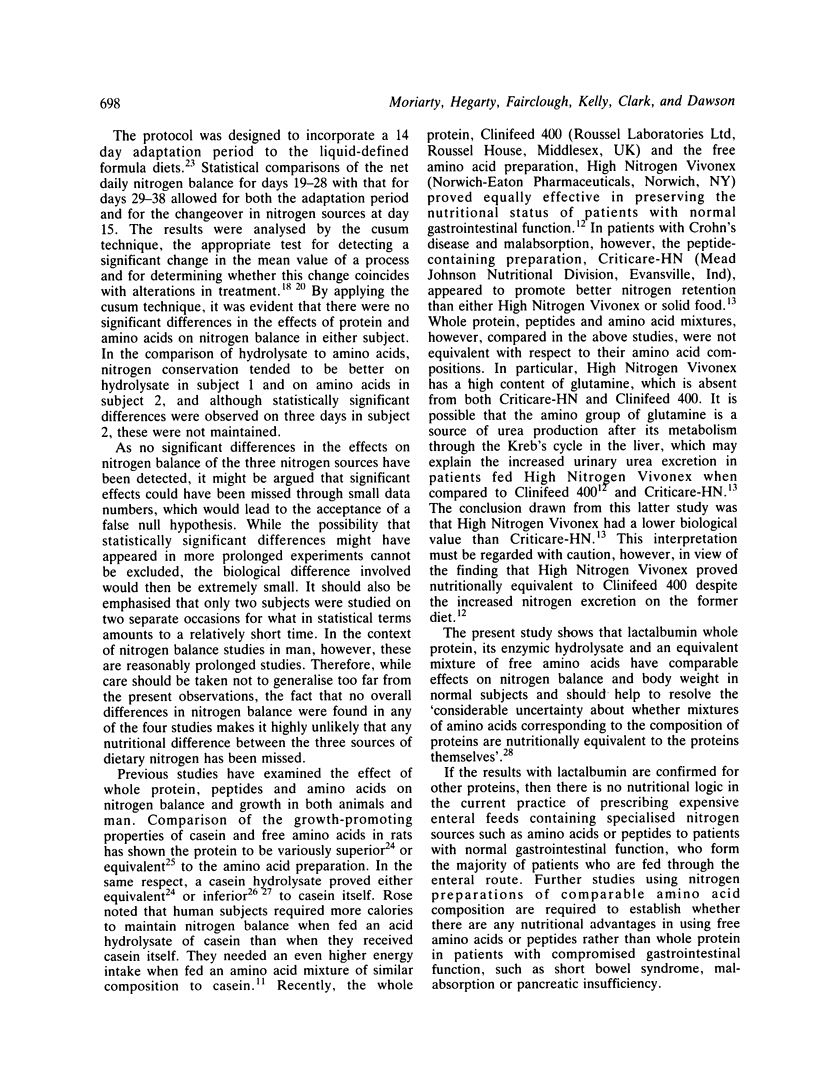
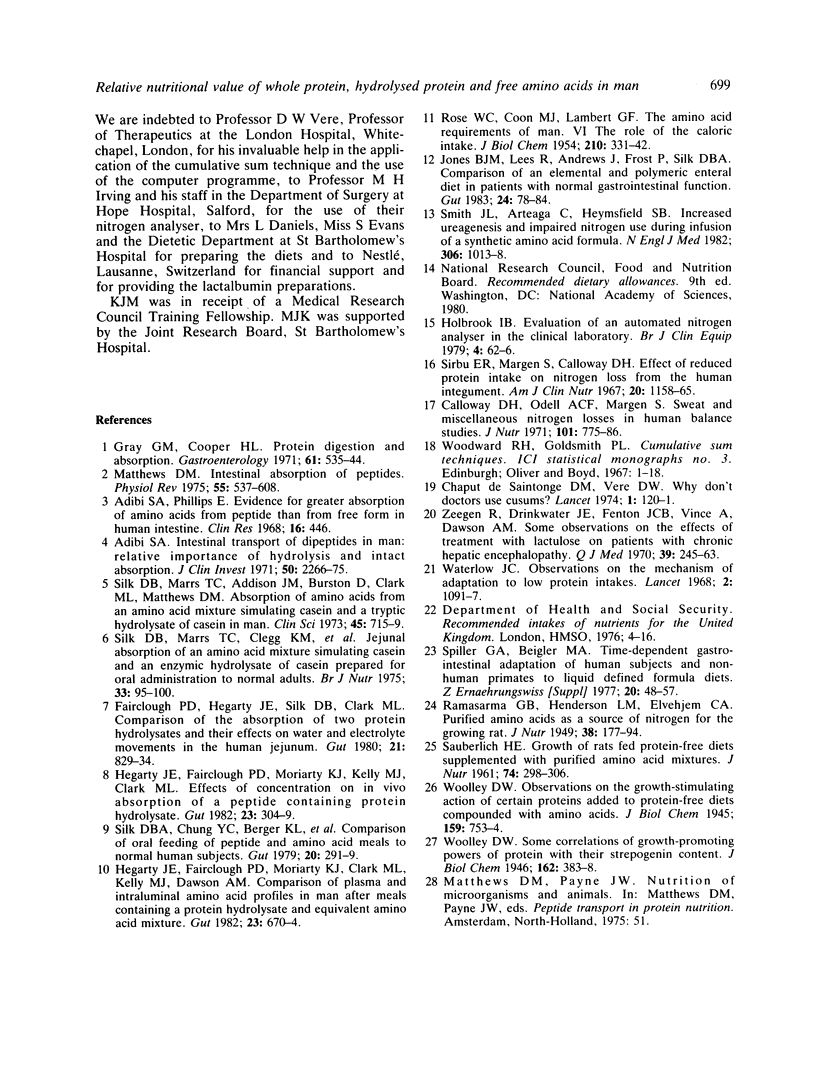
Selected References
These references are in PubMed. This may not be the complete list of references from this article.
- Adibi S. A. Intestinal transport of dipeptides in man: relative importance of hydrolysis and intact absorption. J Clin Invest. 1971 Nov;50(11):2266–2275. doi: 10.1172/JCI106724. [DOI] [PMC free article] [PubMed] [Google Scholar]
- Calloway D. H., Odell A. C., Margen S. Sweat and miscellaneous nitrogen losses in human balance studies. J Nutr. 1971 Jun;101(6):775–786. doi: 10.1093/jn/101.6.775. [DOI] [PubMed] [Google Scholar]
- Chaput de Saintonge D. M., Vere D. W. Why don't doctors use cusums? Lancet. 1974 Jan 26;1(7848):120–121. doi: 10.1016/s0140-6736(74)92345-9. [DOI] [PubMed] [Google Scholar]
- Fairclough P. D., Hegarty J. E., Silk D. B., Clark M. L. Comparison of the absorption of two protein hydrolysates and their effects on water and electrolyte movements in the human jejunum. Gut. 1980 Oct;21(10):829–834. doi: 10.1136/gut.21.10.829. [DOI] [PMC free article] [PubMed] [Google Scholar]
- Gray G. M., Cooper H. L. Protein digestion and absorption. Gastroenterology. 1971 Oct;61(4):535–544. [PubMed] [Google Scholar]
- Hegarty J. E., Fairclough P. D., Moriarty K. J., Clark M. L., Kelly M. J., Dawson A. M. Comparison of plasma and intraluminal amino acid profiles in man after meals containing a protein hydrolysate and equivalent amino acid mixture. Gut. 1982 Aug;23(8):670–674. doi: 10.1136/gut.23.8.670. [DOI] [PMC free article] [PubMed] [Google Scholar]
- Hegarty J. E., Fairclough P. D., Moriarty K. J., Kelly M. J., Clark M. L. Effects of concentration on in vivo absorption of a peptide containing protein hydrolysate. Gut. 1982 Apr;23(4):304–309. doi: 10.1136/gut.23.4.304. [DOI] [PMC free article] [PubMed] [Google Scholar]
- Jones B. J., Lees R., Andrews J., Frost P., Silk D. B. Comparison of an elemental and polymeric enteral diet in patients with normal gastrointestinal function. Gut. 1983 Jan;24(1):78–84. doi: 10.1136/gut.24.1.78. [DOI] [PMC free article] [PubMed] [Google Scholar]
- Matthews D. M. Intestinal absorption of peptides. Physiol Rev. 1975 Oct;55(4):537–608. doi: 10.1152/physrev.1975.55.4.537. [DOI] [PubMed] [Google Scholar]
- ROSE W. C., COON M. J., LAMBERT G. F. The amino acid requirements of man. VI. The rôle of the caloric intake. J Biol Chem. 1954 Sep;210(1):331–342. [PubMed] [Google Scholar]
- Silk D. B., Chung Y. C., Berger K. L., Conley K., Beigler M., Sleisenger M. H., Spiller G. A., Kim Y. S. Comparison of oral feeding of peptide and amino acid meals to normal human subjects. Gut. 1979 Apr;20(4):291–299. doi: 10.1136/gut.20.4.291. [DOI] [PMC free article] [PubMed] [Google Scholar]
- Silk D. B., Clark M. L., Marrs T. C., Addison J. M., Burston D., Matthews D. M., Clegg K. M. Jejunal absorption of an amino acid mixture simulating casein and an enzymic hydrolysate of casein prepared for oral administration to normal adults. Br J Nutr. 1975 Jan;33(1):95–100. doi: 10.1079/bjn19750012. [DOI] [PubMed] [Google Scholar]
- Silk D. B., Marrs T. C., Addison J. M., Burston D., Clark M. L., Matthews D. M. Absorption of amino acids from an amino acid mixture simulating casein and a tryptic hydrolysate of casein in man. Clin Sci Mol Med. 1973 Nov;45(5):715–719. doi: 10.1042/cs0450715. [DOI] [PubMed] [Google Scholar]
- Sirbu E. R., Margen S., Calloway D. H. Effect of reduced protein intake on nitrogen loss from the human integument. Am J Clin Nutr. 1967 Nov;20(11):1158–1165. doi: 10.1093/ajcn/20.11.1158. [DOI] [PubMed] [Google Scholar]
- Smith J. L., Arteaga C., Heymsfield S. B. Increased ureagenesis and impaired nitrogen use during infusion of a synthetic amino acid formula: a controlled trial. N Engl J Med. 1982 Apr 29;306(17):1013–1018. doi: 10.1056/NEJM198204293061702. [DOI] [PubMed] [Google Scholar]
- Spiller G. A., Beigler M. A. Time-dependent gastrointestinal adaptation of human subjects and nonhuman primates to liquid defined formula diets. Z Ernahrungswiss Suppl. 1977;(20):48–57. [PubMed] [Google Scholar]
- Waterlow J. C. Observations on the mechanism of adaptation to low protein intakes. Lancet. 1968 Nov 23;2(7578):1091–1097. doi: 10.1016/s0140-6736(68)91576-6. [DOI] [PubMed] [Google Scholar]
- Zeegen R., Drinkwater J. E., Fenton J. C., Vince A., Dawson A. M. Some observations on the effects of treatment with lactulose on patients with chronic hepatic encephalopathy. Q J Med. 1970 Apr;39(154):245–263. [PubMed] [Google Scholar]


